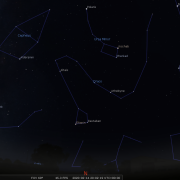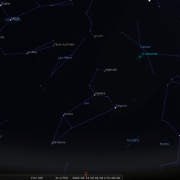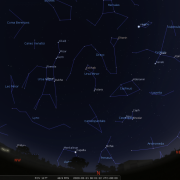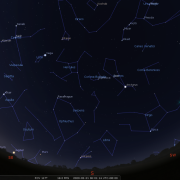
Welcome to the WDAS monthly newsletter for February 2020: a digest of the month's latest contributions to our website. Below you'll find Society News: including details of the Dark Skies festival happening around Whitby; a progress update on the Observatory roof work, and an almost spontaneous Member gathering. That together, of course with your Sky Notes for February.
Society News
This year’s official ‘Dark Sky’ week falls during the end of February – coinciding with the half term break. The society is delighted to be involved in a number of events, hopefully actually managing some observing outside this time. Our first event is a return to the Fox and Hounds, Ainthorpe, on Friday February 21st for a stargazing evening. The event held here last October fell foul to some diabolical weather (low cloud and rain) so it was purely an indoor affair lasting all evening!
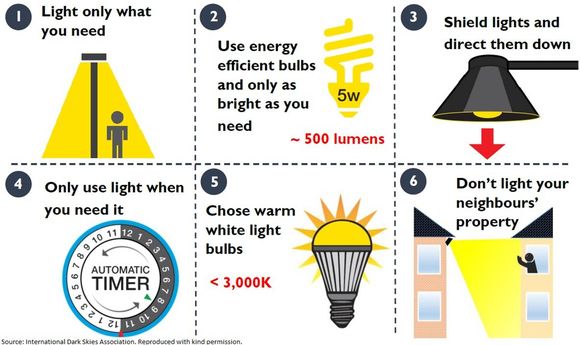
Hosts Vicky and Colin of the Fox & Hounds Hotel are excited on holding star gazing events under the dark skies of the North York Moors and are desperately hoping for better conditions. They have managed to secure an arrangement with the National Parks Danby Moors Centre, whereby guests staying for the Friday event are also able to attend the Danby Moors event the following evening.
The itinerary at the Fox and Hounds event is as follows:
- 17:00h – Welcome & Briefing,
- 18:00h – Dinner.
- 19:00/19.30h – Star Gazing
- 12:00h – De-brief.
I am assuming that if attending members are interested in dinner, (3 courses) some arrangement will be made. Otherwise there is an extensive bar meal menu, or you do not have to eat at all. Further details will be forthcoming at the February meeting on the 4th. If you are interested in making a night of it (food wise) please visit
https://www.foxandhoundsainthorpe.com/eat
Should conditions be favourable we shall need to leave Whitby by 16:15h. The conditions on the day will dictate what equipment we actually do transport.
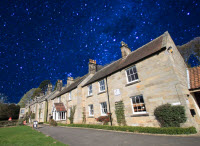 The following evening, Saturday 22nd, we willll, weather permitting, be called in to action again at the Danby Moors Centre, for their Dark Skies Week event. The National Park ‘Dark Sky’ events have all been highlighted widely in the media, including Astronomy Now Magazine, various local newspapers and radio, so if skies are forecast to be clear, public attendance will be high (over 50 -60) and we shall definitely require assistance from members regarding scopes /transport. The event runs from 18:30h-20:30h, and we aim to be setting off around 17:45h to allow time to set up.
The following evening, Saturday 22nd, we willll, weather permitting, be called in to action again at the Danby Moors Centre, for their Dark Skies Week event. The National Park ‘Dark Sky’ events have all been highlighted widely in the media, including Astronomy Now Magazine, various local newspapers and radio, so if skies are forecast to be clear, public attendance will be high (over 50 -60) and we shall definitely require assistance from members regarding scopes /transport. The event runs from 18:30h-20:30h, and we aim to be setting off around 17:45h to allow time to set up.
Winter has so far stayed away from the UK, but i have no doubt it will have some say in proceedings. Suffice to say if conditions are hazardous it will be called off, but if cloud is our only problem, plan B will be used to good effect, ie an indoor presentation. More details will be given at the Feb meeting.
 A week later on the 28th February 2020, we'll be back down at Fylinghall School who have invited us to host their Stargazing Party. Again, last year’s event, although successful was clouded out, so the ‘stack yard’ served as the ‘solar system’ for the scaled planetary demo, which went down very well indeed. Then the Barn theatre acted as the venue for the indoor presentation. I suspect if conditions are clear we shall be setting up on the front lawn in front of the main building.
A week later on the 28th February 2020, we'll be back down at Fylinghall School who have invited us to host their Stargazing Party. Again, last year’s event, although successful was clouded out, so the ‘stack yard’ served as the ‘solar system’ for the scaled planetary demo, which went down very well indeed. Then the Barn theatre acted as the venue for the indoor presentation. I suspect if conditions are clear we shall be setting up on the front lawn in front of the main building.
Further details can be found by contacting Angelique on marketing![]() fylinghall.org .
fylinghall.org .
Who knows what the conditions will be like, no me neither, so Plan B and C will be lurking in the background. It’s going to be a busy week – one way or another.
Over the Christmas break society members finally carried out some necessary remedial work on the observatory dome roof, stripping and then re-felting the door flaps. Saul had noticed earlier in the month that the felt looked somewhat ‘dodgy’ especially on the flaps and on closer scrutiny in daylight it was clear it had deteriorated to such an extent it needed to be replaced.

Having already roughly measured up for roof felt and lathes required for the whole roof, Saul, met Andy L, Keith and Mark at the observatory on a dry but slightly chilly Saturday (Dec 29th). Utilising some shorter ladders propped against the dome from the flat roof, Saul, Mark and Andy, took it in turns to strip the old felt right back to the wood, removing old pitch and as many felt nails as possible. Keith, footed ladder from the ground and passed things up. Having measured a length of felt required for a door flap, a new piece was cut, before it was passed up onto the flat roof in readiness to be torched on. Saul used a large gas bottle and torch for this.
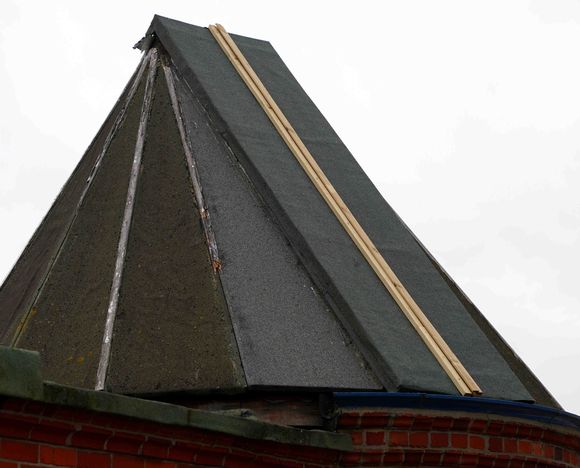
It was tricky (to say the least) holding the felt roll at the top of the dome doors, tacking it and then unrolling it down the door whilst torching it on in a straight line, without it running off. It’s trickier still in a blustery wind, which seemed to spring up from nowhere. Further felt side cheeks were required, a double felt layer over the hinged edge of the door flaps. Saul also double felted the bottom of the door flaps to help maintain the integrity of them.
Whilst Saul and Andy finished off the first flap, Mark and Keith cut the felt strips for the second door flap. This went on a little easier, although Mark got called away for a while and missed most of the torching. The overlapping lathes were then attached to the door flaps to maintain the weather seal down the joint when closed. The shape of the dome meant a few health and safety rules were stretched (or overlooked), with Saul, Andy and Mark clambering up and down the dome and Saul ‘peaking’ the dome summit on a number of occasions.
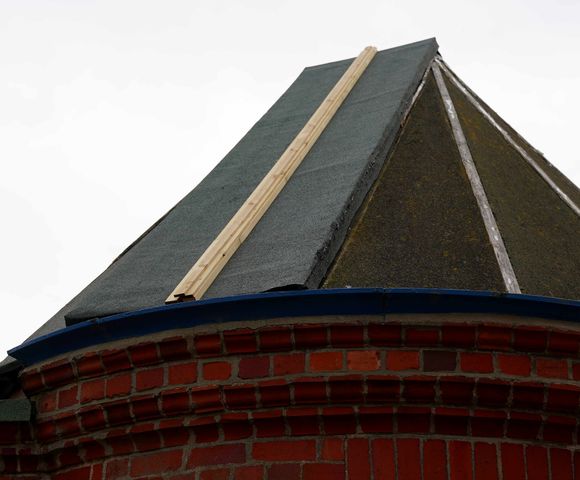
Major jobs never go according to plan, and this was no exception, but with the afternoon wearing on we finally succeeded in closing up the dome once again. It’s a start, and there is much to do yet, but perhaps the hardest section has been tackled. We also now have a better understanding how the remaining felt panels will be replaced and the methods used. This will be undertaken in early April, when days are lighter and warmer.(hopefully)
Many thanks for Andy and Keith in assisting, but most of all to Saul. Without whose knowledge and workmanship the job would not have been possible.
Finally, castaway member Andi Ye (who is located in Tenerife) was back in Britain for a week towards the end of January. So we thought it would be good idea to meet up and have a chinwag. It was all last minute stuff, but seven members (Andi Ye, Andy L, Keith, Lee, Mark, Phil and Elaine) made it along to the corner bar at the Royal Hotel for ‘bingo and dominoes’ at the ‘pipe and slippers evening’.
No, actually it was ok, you could hear yourself think, the seats were comfy and the ale decent. It was great to see Andi again, catch up on matters, with the conversation ranging from dark skies and locations in Tenerife, to corporal punishment... strange old evening, but most enjoyable!


Deep Fake?
'Is this the real Lee? Is this just fantasy?
Who the pole dancer, behind Phil and Keith could be?
Open your eyes, look out to the skies and see
Is that a lens flare, or a lighthouse that we can see?'
(Lyrcs: Planet Mercury)
Subscription renewals for the coming year are due by the end of February. Subscription rates are £12, for adults with subsidized rates at £8 for under 16s.
You can bring subs along to the W.D.A.S monthly meeting in February, or if you cannot make the meetings Cheques are made payable to;- Whitby & District Astronomical Society, Please address to Mark Dawson - 33 laburnum Grove, Whitby. YO211HZ. Many thanks for your continued support.
As of going to press just a few copies of Night Scenes 2020 remain. Price is £5.
Sky Notes
In this month's Sky Notes:
Planetary Skylights
Evening Planets

At magnitude -4.3 Venus completely dominates the evening sky over in the west, so much so even the most casual of observers cannot fail to notice it.
Over the course of the month Venus continues to track up through the descending autumn constellations of Aquarius and Pisces and is visible still after 21:00h by the month’s end. Through the telescope there is little to write home about; the surface invisible under the duvet of cloud, however occasionally some vague cloud markings can be seen and the use of a filter, orange or red (either Wratten 21 or 23a or 25 and 29) will help with this. You will notice the phase. A good tip is view Venus in bright twilight, when it’s far less glary to the eye. The crescent moon pays Venus a visit on the 27th.
08-Feb-2020 at 17:30h (WSW): Apparition Paths for Venus and Mercury in the Evening Sky.
(Click for full-sized image)
 Venus is certainly the brightest planet visible; however it is the other inferior planet (Mercury) which should be considered the planetary highlight of the month. (An inferior planet is one which orbits the sun closer than the earth, i.e. Venus or Mercury) Arcing up, low above the WSW–W horizon, before departing again after mid month, Mercury has its best evening apparition of the year.
Venus is certainly the brightest planet visible; however it is the other inferior planet (Mercury) which should be considered the planetary highlight of the month. (An inferior planet is one which orbits the sun closer than the earth, i.e. Venus or Mercury) Arcing up, low above the WSW–W horizon, before departing again after mid month, Mercury has its best evening apparition of the year.
At Mag -1.1 the innermost planet will be brightest at the start of the month, but lower down, so perhaps Feb 3-8th is the optimum observing window. View towards the WSW (lower right of Venus) compass bearing 235-240 degrees around 30-40 minutes after sunset (17:20-17:40) scanning above the horizon approximately 6 degrees. Look for a fairly bright ‘star’ low in the twilight. If it does elude your eyes, use binoculars to help spot it. Mercury reaches greatest elongation east of the Sun on Feb 10th but has faded slightly (-0.7).
Telescopically there is not a great deal to view, but you may notice the phase of around 51 percent; roughly a ‘first quarter’. The low altitude also usually makes for unsteady seeing, but it’s worth tracking down the messenger of the gods, the most elusive of the five naked eye planets
 Uranus resides in Aries, which is slipping down towards the west, but still well placed high to the SW as twilight falls. Although technically visible to the naked eye at mag +5.9, in reality binoculars, or better still, a telescope are required to spot it. Uranus resides just within the borders of Aries quite some distance below the ‘crooked line’ asterism of the Ram. If you have a constellation chart or App etc, use Mesarthim and iota Aries as pointers to locate Uranus, which resides roughly 3 times the distance between these stars and a tad to the right, below them. Through a telescope Uranus resembles a very small disk of subtle grey/green hue.
Uranus resides in Aries, which is slipping down towards the west, but still well placed high to the SW as twilight falls. Although technically visible to the naked eye at mag +5.9, in reality binoculars, or better still, a telescope are required to spot it. Uranus resides just within the borders of Aries quite some distance below the ‘crooked line’ asterism of the Ram. If you have a constellation chart or App etc, use Mesarthim and iota Aries as pointers to locate Uranus, which resides roughly 3 times the distance between these stars and a tad to the right, below them. Through a telescope Uranus resembles a very small disk of subtle grey/green hue.
 Neptune is technically visible although by mid February is lost in solar glare, so we won’t dwell on it until it returns later in the spring.
Neptune is technically visible although by mid February is lost in solar glare, so we won’t dwell on it until it returns later in the spring.
Dawn Planets
Until recently the solitary dawn planet; Mars is joined by Jupiter and Saturn in February, with the crescent moon passing by each of them in turn later in the month.

 At Mag + 1.3 Mars is certainly not the conspicuous object it will eventually become later in the year and is currently only as bright as an average first magnitude star. February commences with Mars low in the SSE, upper left of Antares, ‘the rival of Mars’ and chief star in Scorpius.
At Mag + 1.3 Mars is certainly not the conspicuous object it will eventually become later in the year and is currently only as bright as an average first magnitude star. February commences with Mars low in the SSE, upper left of Antares, ‘the rival of Mars’ and chief star in Scorpius.
Antares actually appears brighter and is of a similar deep amber hue to Mars, confusing the unwary who perhaps think it is Mars! Careful observations over the course of the month will reveal the real Mars however, as it moves relatively quickly against the background stars of Ophuichus and above the ‘teapot’ asterism of Sagittarius. View around 06:15h. For the time being telescope observations of the red planet will be somewhat disappointing, the as yet tiny disk distorted in turbulent air. It will be several months before this starts change. A waning crescent resides right of Mars on the 18th.
Jupiter has returned to the morning sky, emerging from the glare of the Sun and edging up into the eastern twilight sky. Jupiter appears considerably more prominent (Mag -1.9) than Mars and should be readily identified with the naked eye low to the horizon. Jupiter’s disk size in the eyepiece far exceeds that of Mars (even when Mars is at a close opposition) but the low altitude will again make it a tricky object to view satisfactory through a telescope. The ‘dance’ of the Galilean moons is however always fascinating viewing over time. The Moon lies to the right on the 19th.
 Saturn also emerges into the dawn sky after the first week of February, visible just above the SE horizon to the left of Jupiter around 06:45h. At Mag +0.5) the pearly hue of Saturn is not as bright as Jupiter, but brighter than Mars. The rings will be apparent in a telescope, but better observing days await later in the year. The moon lies lower right on the morning of the 20th.
Saturn also emerges into the dawn sky after the first week of February, visible just above the SE horizon to the left of Jupiter around 06:45h. At Mag +0.5) the pearly hue of Saturn is not as bright as Jupiter, but brighter than Mars. The rings will be apparent in a telescope, but better observing days await later in the year. The moon lies lower right on the morning of the 20th.
Meteors

There is just one minor meteor shower this month, the Alpha Aurigids. The peak (if you can call it that) falls between Feb 6 - 9th. The Zenith Hourly Rate only reaches sporadic levels, barely half a dozen per hour, but if you do spot a meteor heading away from the direction of the zenith, (overhead) where the constellation of Auriga resides at this time of year, it is likely to be an Aurigid!
|
Looking North
Mid-February - 20:00h |
Looking South |
|
Looking East
Mid-February - 20:00h |
Looking West
Mid-February - 20:00h |
|
Northern Aspect
Mid-February - 20:00h |
Southern Aspect
Mid-February - 20:00h |
|
Looking North (Early)
Mid-February - 06:00h |
Looking South (Early)
Mid-February - 06:00h |
Additional Image Credits:
- Planets and Comets where not otherwise mentioned: NASA
- Sky Charts: Stellarium Software







